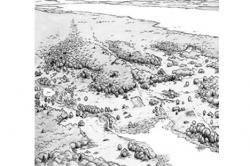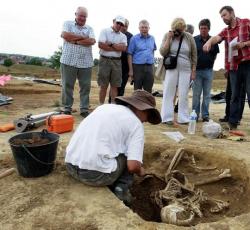- 02 - 03 JUILLET
- INDI-UNI : 
PRE-INSCRIPTION : 15 Juin – 15 Août
PRE-REGISTRATION: June 15th - August 15th
- SUISSE –  Onnens - Les archéologues ont pu reconstituer le paysage d’il y a plus de 6000 ans. Ils ont retrouvé un vallon dans lequel s’étaient formés deux petits lacs aujourd’hui disparus. Ainsi Onnens qui ne bénéficie plus que du lac de Neuchâtel a compté jusqu’à trois lacs. Les fouilleurs ont retrouvé une maison de grande taille, puisqu’elle faisait 18 mètres de long. Elle date de 2400 avant J.-C. et était faite de poteaux de bois et de murs de terre et de paille et entourés de greniers à céréales. Une perle d’ambre venue de la Baltique, des silex trouvés loin de leurs lieux de production ainsi qu’une alène (poinçon) de cuivre probablement extrait des Alpes démontre la mobilité des gens à une époque qu’on imagine statique. Et cela est d’autant plus surprenant qu’il n’existait pas de routes, mais sans doute des chemins muletiers qui n’ont laissé aucune trace. En 1500 av. J.-C., le climat devient plus rude et le lac de Neuchâtel tout proche se fait capricieux: il monte et il redescend menaçant les villages lacustres. C’est à ce moment que se crée un petit hameau sur la colline d’Onnens: les lacustres ont probablement déserté les rives pour défricher ce coin de pays. Ils vivent dans une certaine aisance: en témoigne par exemple un lingot de bronze qui démontre l’existence d’un atelier de métallurgie. Les archéologues sont parvenus a identifier des morceaux de mur fait de terre et de paille de l’époque du hameau: en négatif se devinent encore les branches de noisetiers qui servaient à supporter ces murs. Des signes difficiles à identifier et qui viennent documenter une période peu connue du grand public.
Onnens - Les archéologues ont pu reconstituer le paysage d’il y a plus de 6000 ans. Ils ont retrouvé un vallon dans lequel s’étaient formés deux petits lacs aujourd’hui disparus. Ainsi Onnens qui ne bénéficie plus que du lac de Neuchâtel a compté jusqu’à trois lacs. Les fouilleurs ont retrouvé une maison de grande taille, puisqu’elle faisait 18 mètres de long. Elle date de 2400 avant J.-C. et était faite de poteaux de bois et de murs de terre et de paille et entourés de greniers à céréales. Une perle d’ambre venue de la Baltique, des silex trouvés loin de leurs lieux de production ainsi qu’une alène (poinçon) de cuivre probablement extrait des Alpes démontre la mobilité des gens à une époque qu’on imagine statique. Et cela est d’autant plus surprenant qu’il n’existait pas de routes, mais sans doute des chemins muletiers qui n’ont laissé aucune trace. En 1500 av. J.-C., le climat devient plus rude et le lac de Neuchâtel tout proche se fait capricieux: il monte et il redescend menaçant les villages lacustres. C’est à ce moment que se crée un petit hameau sur la colline d’Onnens: les lacustres ont probablement déserté les rives pour défricher ce coin de pays. Ils vivent dans une certaine aisance: en témoigne par exemple un lingot de bronze qui démontre l’existence d’un atelier de métallurgie. Les archéologues sont parvenus a identifier des morceaux de mur fait de terre et de paille de l’époque du hameau: en négatif se devinent encore les branches de noisetiers qui servaient à supporter ces murs. Des signes difficiles à identifier et qui viennent documenter une période peu connue du grand public.
http://www.24heures.ch/vaud-regions/actu/onnens-possedait-trois-lacs-2011-06-21
- FRANCE –  – Rosheim - Le chantier du futur lotissement du Rittergass à Rosheim a permis la mise au jour d’un site d’occupation remontant à l’époque néolithique. Sans grande surprise donc, les archéologues ont fait bonne pioche. Ils n’ont pas eu à trop forcer leur talent puisque, en 1990, de l’autre côté de la route, la construction d’un autre lotissement avait déjà révélé la présence d’une implantation humaine préhistorique. Aujourd’hui, sur environ 1,5 hectare de chantier, les archéologues ont mis au jour un lieu de vie occupé entre moins 5 000 ans avant Jésus-Christ et moins 500 ans. Des traces ténues, mais palpables : des emplacements de trous alignés, témoins des troncs d’arbres ayant servi d’ossatures à des maisons ; des fosses proches où les bâtisseurs ont puisé le lœss indispensable pour fabriquer le torchis des parois de l’habitation ; et surtout, les éternels silos à grains enterrés où la population stockait ses céréales. Des silos qui, comme dans beaucoup d’autres sites d’Alsace, ont ensuite été réutilisés soit comme fosses dépotoirs, soit comme lieux de sépulture. C’est ainsi que sur le site de Rosheim, quelques tombes ont été retrouvées dont une double où deux corps reposent l’un sur l’autre sans que l’on sache encore si les deux défunts sont liés ou s’ils ont été inhumés à la même date. Le chantier, inachevé, a déjà permis de mettre au jour quelques objets. Des haches ou herminettes de pierre, des fragments de meules de pierre, mais aussi un bracelet de bronze et une agrafe pour vêtement d’une période plus tardive.
– Rosheim - Le chantier du futur lotissement du Rittergass à Rosheim a permis la mise au jour d’un site d’occupation remontant à l’époque néolithique. Sans grande surprise donc, les archéologues ont fait bonne pioche. Ils n’ont pas eu à trop forcer leur talent puisque, en 1990, de l’autre côté de la route, la construction d’un autre lotissement avait déjà révélé la présence d’une implantation humaine préhistorique. Aujourd’hui, sur environ 1,5 hectare de chantier, les archéologues ont mis au jour un lieu de vie occupé entre moins 5 000 ans avant Jésus-Christ et moins 500 ans. Des traces ténues, mais palpables : des emplacements de trous alignés, témoins des troncs d’arbres ayant servi d’ossatures à des maisons ; des fosses proches où les bâtisseurs ont puisé le lœss indispensable pour fabriquer le torchis des parois de l’habitation ; et surtout, les éternels silos à grains enterrés où la population stockait ses céréales. Des silos qui, comme dans beaucoup d’autres sites d’Alsace, ont ensuite été réutilisés soit comme fosses dépotoirs, soit comme lieux de sépulture. C’est ainsi que sur le site de Rosheim, quelques tombes ont été retrouvées dont une double où deux corps reposent l’un sur l’autre sans que l’on sache encore si les deux défunts sont liés ou s’ils ont été inhumés à la même date. Le chantier, inachevé, a déjà permis de mettre au jour quelques objets. Des haches ou herminettes de pierre, des fragments de meules de pierre, mais aussi un bracelet de bronze et une agrafe pour vêtement d’une période plus tardive.
http://www.lalsace.fr/actualite/2011/06/23/rosheim-replonge-dans-sa-prehistoire
- PAKISTAN – Badalpur - The archaeologists and students of Taxila Institute of Asian Civilizations (TIAC), Quaid-i-Azam University, have discovered huge number of antiquities of 1st Century to 4th Century CE during archaeological excavations on the Buddhist Monastery of Badalpur. During the current excavation the remains of assembly hall, kitchen, stores and steward rooms have been exposed and a good number of antiquities were discovered. The antiquities discovered were including potteries, gold and copper coins, seals and sealings, beads, iron objects and grinding mills. But the most remarkable discovery of the excavations is the discovery of a Mathura sculpture of the Buddha made from reddish sand stone. The sculpture depicts a Buddha seated on a throne with a cross legged, both soles of the feet having Dharmachakra symbols. The right hand is in abhaya mudra with a wheel of law on the palm. Pipal tree is engraved at the back of the sculpture. Similar Mathura style sculpture of Buddha was also discovered from the surface of Bhari Dheri site in Taxila Valley. staff report
http://www.dailytimes.com.pk/default.asp?page=2011\07\02\story_2-7-2011_pg11_4
- INDE – Dwarka - A rare Lodi-era baoli unearthed in Dwarka will soon come under the protection of Delhi government's state archaeology department. The baoli (stepwell) at Dwarka is a unique structure and the only monument of its kind in the area. The baoli dates back to the Lodi era, with typical Lodi architecture and prominent arches, but very little else is known about the structure. The depth remains unclear as the baoli has been filled in with muck and vegetation. Still, one can easily see the opening of the baoli, some steps leading inside it as well as the rubble masonry used in its construction. "Many baolis were lost or filled in completely due to large scale construction. Apart from the bigger baolis like Ugrasen ki baoli or Rajon ki baoli, etc., there were many small baolis from the Lodi and Mughal times. These were used extensively as a source of water for the locals. Unfortunately, only a fraction of them still survive,'' said a historian.
http://timesofindia.indiatimes.com/city/delhi/Dwarka-baoli-to-come-under-govt-protection/articleshow/9068143.cms
- USA - Old New Castle - While the Dutch House was built between 1690 and 1710, the property contained an earlier log structure that existed by 1682. No above ground evidence of this earlier log structure exists, but there may be evidence underground that helps us understand how people lived on and used this property from the 17th through the 20th centuries. In preparation for this investigation, John Milner Associates used ground penetrating radar to study the site, and identified the locations of several underground anomalies. These anomalies indicate possible historic features that may yield evidence of early structures or other features that will help us understand how the site was used.
http://www.communitypub.com/events/x817760487/Archaeology-Day-at-the-Dutch-House-coming-in-July
- INDE – Thiruvananthapuram - Hundreds of kilos of coins issued by the government of erstwhile Travancore (raasi) and those from the time of Napoleon and the British East India Company were among the articles that were counted and weighed on the second day of inventorying of the contents of vault A of Sree Padmanabhaswamy temple. The inventorying is being done by a seven-member panel appointed by the Supreme Court. An expert from the Department of Archaeology was present on Friday. The articles found inside the vaults are being counted and weighed. Their worth is not being assessed now.The Travancore-era coins include more than 14 kg of half-sovereigns believed to have been offered during ‘thulabharams' made over the centuries. More than 70 kg of Venetian coins were reportedly found on Friday, along with many kilos of East India company coins minted at (then) Madras. Coins of Australian origin and those from Mysore were also reportedly counted and weighed. The inventoried articles were tagged, bagged and deposited back inside the vault. The inventorying of vaults A to F began on June 27; on the first day C was opened. D and F were opened on June 28. A and B — the contents of which are the subject of controversy — were opened on June 29. A preliminary inspection of A showed it to be mostly empty.
http://m.thehindu.com/news/cities/Thiruvananthapuram/article2151308.ece/?secid=3044
- USA – Paso Robles - Archaeologists working on the Nacimiento Water Project unearthed a large collection of Chumash artifacts, ranging from bowl mortar and pestles, a milling stone slab, and a number of other stone tools, bone fragments and shells. More than 500 pieces were found and are estimated to be 5,000 to 10,000 years old.
http://www.sanluisobispo.com/2011/06/30/1664844/large-collection-of-chumash-artifacts.html